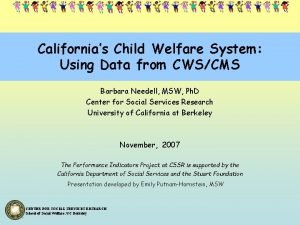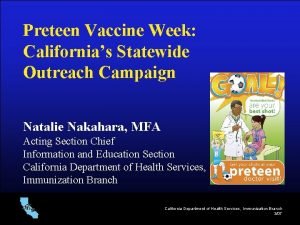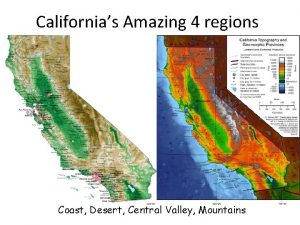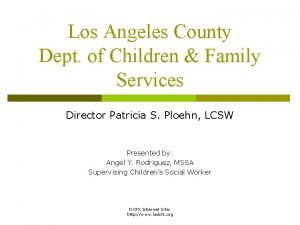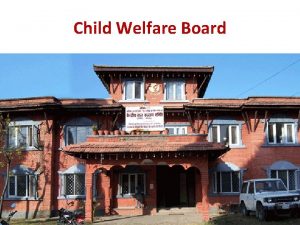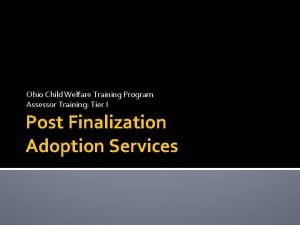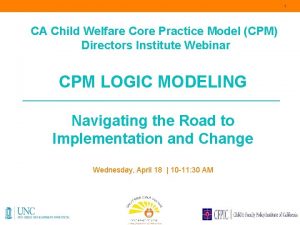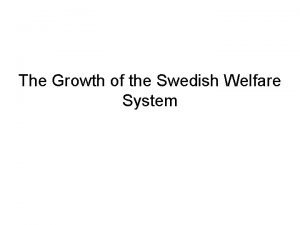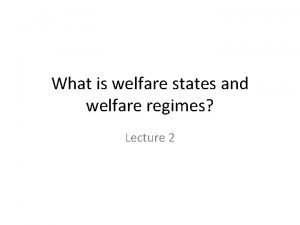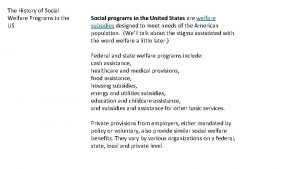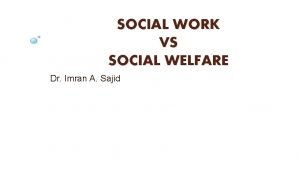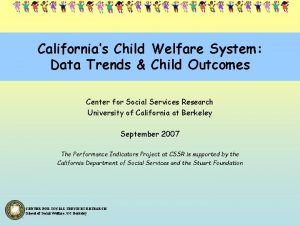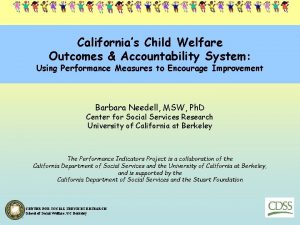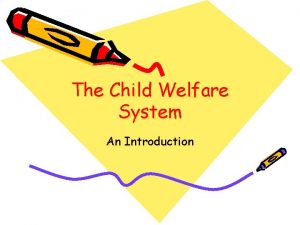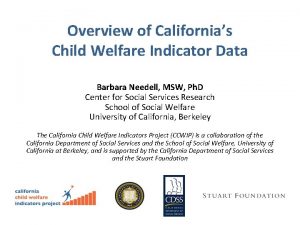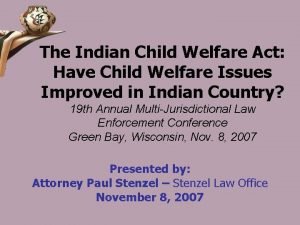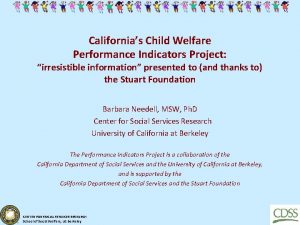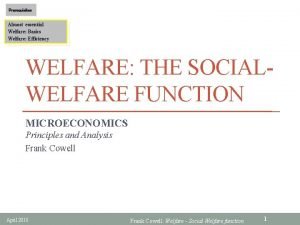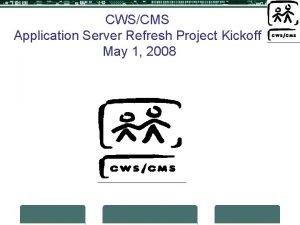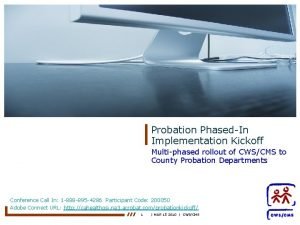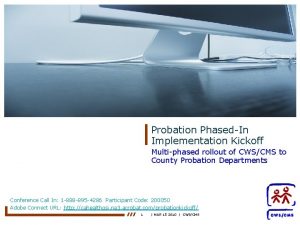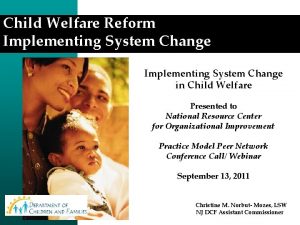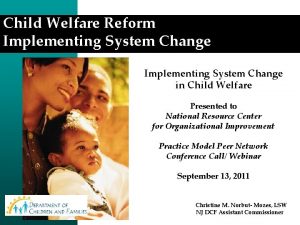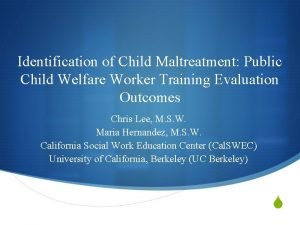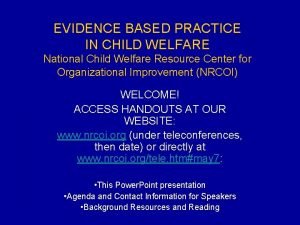Californias Child Welfare System Using Data from CWSCMS




























- Slides: 28

California’s Child Welfare System: Using Data from CWS/CMS Barbara Needell, MSW, Ph. D Center for Social Services Research University of California at Berkeley November, 2007 The Performance Indicators Project at CSSR is supported by the California Department of Social Services and the Stuart Foundation Presentation developed by Emily Putnam-Hornstein, MSW CENTER FOR SOCIAL SERVICES RESEARCH School of Social Welfare, UC Berkeley

Tracking Child Welfare Outcomes Rate of Referrals/ Substantiated Referrals Reentry to Care Permanency Through Reunification, Adoption, or Guardianship Counterbalanced Indicators of System Performance Length of Stay Stability of Care Home-Based Services vs. Out of Home Care Use of Least Restrictive Form of Care Positive Attachments to Family, Friends, and Neighbors Source: Usher, C. L. , Wildfire, J. B. , Gogan, H. C. & Brown, E. L. (2002). Measuring Outcomes in Child Welfare. Chapel Hill: Jordan Institute for Families,

2002 -2006 California: Referrals, Substantiations & Entry Rates (per 1, 000 Children) Referral Rates Substantiation Rates Entry Rates CENTER FOR SOCIAL SERVICES RESEARCH School of Social Welfare, UC Berkeley

1998 to 2007 California: First Entries by First Placement Type (children in care for 8 or more days) TOTAL Foster Kinship Group/Shelter FFA 1998 1999 2000 CENTER FOR SOCIAL SERVICES RESEARCH School of Social Welfare, UC Berkeley 2001 2002 2003 2004 2005 2006 2007

1998 to 2007 California: Foster Care Caseload by Placement Type Kinship TOTAL Foster FFA Group/Shelter 1998 1999 2000 CENTER FOR SOCIAL SERVICES RESEARCH School of Social Welfare, UC Berkeley 2001 2002 2003 2004 2005 2006 2007

CA CWS Outcomes System • California Child Welfare System Improvement and Accountability Act (AB 636) became law in 2001 and went into effect in January 2004—quarterly outcomes reports at state and county level. –We have eliminated some of the original ab 636 measures and have included all new federal measures. –Provides additional measures needed to understand performance (e. g. , % of siblings placed together). –We are working on additional measures of well-being. • Mirrors Family to Family Outcomes • Retains key process measures (e. g. , child visits, time to investigation) • Began with county self assessments and System Improvement Plans (SIPS) that identified key challenges and strengths • Peer Quality Case Reviews (PQCRs) are being conducted in each county to dig deeper into specific issues

CFSR National Standards • Round 1 of the CFSRs – 2 of the “outcomes” = 6 items (2 for safety, 4 for permanency) – States failing to meet a given standard had to include that item in their Performance Improvement Plans (PIPs) • Round 2 of the CFSRs – Also comprised of 6 items with standards attached – BUT…this time the permanency standards are comprised of 15 different measures distilled into four composites – TOTAL of 17 FEDERAL MEASURES CENTER FOR SOCIAL SERVICES RESEARCH School of Social Welfare, UC Berkeley

Indicator 1 Safety Indicator 2 Composite 1 Component A Component B Measure 1 2 3 4 5 Composite 2 Component A Component B Component C Measure Measure Composite 3 Component A Component B Measure 1 Measure 2 Measure 3 Permanency Composite 4 CENTER FOR SOCIAL SERVICES RESEARCH School of Social Welfare, UC Berkeley Measure 1 Measure 2 Measure 3

Working with Composites • National standards for both the safety indicators and permanency composites are based on State performance in 2004, 75 th percentile • In California, we at CSSR attempt to replicate each of the measures, break them out by child welfare and probation agencies, and report/update quarterly. • Although national standards have been set for the composites rather than individual measures… – The goal is to improve State performance on all measures (every improvement reflects a better outcome for children) – Improvement on any given measure will result in an increase in the overall composite score – Local data analysis should reveal which measures need to be targeted, and how CENTER FOR SOCIAL SERVICES RESEARCH School of Social Welfare, UC Berkeley

California: CWS Outcomes System: UCB Measures, Percent IMPROVEMENT January 2004 compared to October 2007 CENTER FOR SOCIAL SERVICES RESEARCH School of Social Welfare, UC Berkeley Note: (+) indicates a measure where a % increase equals improvement. (-) indicates a measure where a % decrease equals improvement. indicates a measure where performance declined.

California: CWS Outcomes System: UCB Measures, Percent IMPROVEMENT January 2004 compared to October 2007 CENTER FOR SOCIAL SERVICES RESEARCH School of Social Welfare, UC Berkeley Note: (+) indicates a measure where a % increase equals improvement. (-) indicates a measure where a % decrease equals improvement. indicates a measure where performance declined.

January 2004 -October 2007 California CWS Outcomes System: Federal Measures, Percent IMPROVEMENT CENTER FOR SOCIAL SERVICES RESEARCH School of Social Welfare, UC Berkeley Note: (+) indicates a measure where a % increase equals improvement. (-) indicates a measure where a % decrease equals improvement. indicates a measure where performance declined.

2007 California CWS Outcomes System: Performance Relative to Federal Standard/Goal 100% CENTER FOR SOCIAL SERVICES RESEARCH School of Social Welfare, UC Berkeley

2002 to 2007 California: C 3. 1: Exits to Permanency (24 m In Care), by Exit Type Total # in Care 24 m+ % Exits to Permanency % Adoption % Reunification % Guardianship CENTER FOR SOCIAL SERVICES RESEARCH School of Social Welfare, UC Berkeley

2002 to 2007 California: C 3. 3: In Care 3 Years Or Longer (Emancipated Or Age 18) # in Emancipating or Age 18 % In Care 3+ Years National Goal CENTER FOR SOCIAL SERVICES RESEARCH School of Social Welfare, UC Berkeley

2002 to 2007 California: C 4. 1, 2, 3: Placement Stability 8 Days to 12 Months in Care 12 to 24 Months In Care At Least 24 Months In Care CENTER FOR SOCIAL SERVICES RESEARCH School of Social Welfare, UC Berkeley

2002 to 2007 Count California: C 4. 1, 2, 3: Placement Stability CENTER FOR SOCIAL SERVICES RESEARCH School of Social Welfare, UC Berkeley

1998 to 2007 California: First Entries by Race/Ethnicity (children in care for 8 or more days) TOTAL Hispanic White Black Asian/PI Native American 1998 1999 2000 CENTER FOR SOCIAL SERVICES RESEARCH School of Social Welfare, UC Berkeley 2001 2002 2003 2004 2005 2006 2007

1998 to 2007 California: Foster Care Caseload by Race/Ethnicity TOTAL Black Hispanic White Asian/PI Native American 1998 1999 2000 CENTER FOR SOCIAL SERVICES RESEARCH School of Social Welfare, UC Berkeley 2001 2002 2003 2004 2005 2006 2007

2000 First Entries California: Percent Exited to Permanency 72 Months From Entry 88% CENTER FOR SOCIAL SERVICES RESEARCH School of Social Welfare, UC Berkeley 79%

2000 First Entries California: Percent Exited to Permanency 72 Months From Entry by Relative vs. Non-Relative Placement CENTER FOR SOCIAL SERVICES RESEARCH School of Social Welfare, UC Berkeley =94% =84% =75%

2006 California: Referrals per 1, 000 by Age and Ethnicity *Series Total CENTER FOR SOCIAL SERVICES RESEARCH School of Social Welfare, UC Berkeley

2006 California: Substantiated Referrals per 1, 000 by Age and Ethnicity *Series Total CENTER FOR SOCIAL SERVICES RESEARCH School of Social Welfare, UC Berkeley

2006 California: Entries to Foster Care per 1, 000 by Age and Ethnicity *Series Total CENTER FOR SOCIAL SERVICES RESEARCH School of Social Welfare, UC Berkeley

2006 California: Children in Foster Care per 1, 000 by Age and Ethnicity *Series Total CENTER FOR SOCIAL SERVICES RESEARCH School of Social Welfare, UC Berkeley

Public Data: Putting it All Out There • PROS: – Greater performance accountability – Community awareness and involvement, encourages public-private partnerships – Ability to track improvement over time, identify areas where programmatic adjustments are needed - County/County and County/State collaboration • CONS: – Potential for misuse, misinterpretation, and misrepresentation – Available to those with agendas or looking to create a sensational headline – Misunderstood data can lead to the wrong policy decisions – “Torture numbers, and they’ll confess to anything” Gregg Easterbrook CENTER FOR SOCIAL SERVICES RESEARCH School of Social Welfare, UC Berkeley

DATA ABUSE will not help end CHILD ABUSE Beware: • County/state rankings on individual measures • Composite scores that mask issues • Small populations • Inappropriate views • Logical “flipping” Consider: • Performance over time • Age, gender and race/ethnicity • Interaction among outcomes (counterbalance) • Local practice and policy changes needed to impact outcomes CENTER FOR SOCIAL SERVICES RESEARCH School of Social Welfare, UC Berkeley

Barbara Needell bneedell@berkeley. edu 510. 642. 1893 510. 290. 6334 (pcs) CSSR. BERKELEY. EDU/UCB_CHILDWELFARE Needell, B. , Webster, D. , Armijo, M. , Lee, S. , Cuccaro-Alamin, S. , Shaw, T. , Dawson, W. , Piccus, W. , Magruder, J. , Exel, M. , Conley, A. , Smith, J. , Dunn, A. , Frerer, K. , & Putnam Hornstein, E. , (2007). Child Welfare Services Reports for California. Retrieved [month day, year], from University of California at Berkeley Center for Social Services Research website. URL: <http: //cssr. berkeley. edu/UCB_CHILDWELFARE/> CENTER FOR SOCIAL SERVICES RESEARCH School of Social Welfare, UC Berkeley
 Cwscms
Cwscms Grade californias vaccine
Grade californias vaccine Californias natural harbour
Californias natural harbour System collections generic
System collections generic National programs
National programs National child policy 1974
National child policy 1974 International child welfare agencies
International child welfare agencies All india women's conference was founded by
All india women's conference was founded by Children and family services los angeles
Children and family services los angeles Central child welfare board
Central child welfare board Ohio child welfare training program
Ohio child welfare training program Child welfare
Child welfare Vr3 child welfare foundation
Vr3 child welfare foundation Cpm implementation
Cpm implementation 패자트리
패자트리 Swedish welfare system meme
Swedish welfare system meme Welfare management system
Welfare management system R.a. 9344
R.a. 9344 Dtfd switch
Dtfd switch Earth system data explorer
Earth system data explorer What is welfare
What is welfare What is welfare
What is welfare Cdm welfare facilities
Cdm welfare facilities What is welfare
What is welfare Monopoly deadweight loss
Monopoly deadweight loss Voluntary health and welfare organization examples
Voluntary health and welfare organization examples What is welfare
What is welfare Welfare programs in the us
Welfare programs in the us Social welfare vs social work
Social welfare vs social work
